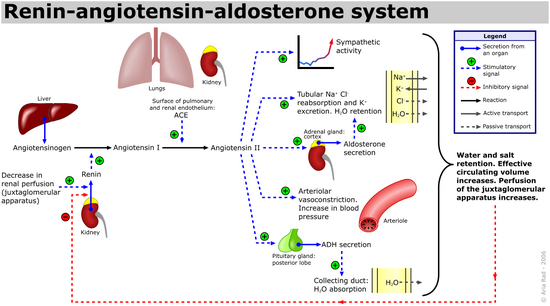| (One intermediate revision by the same user not shown) | |||
| Line 24: | Line 24: | ||
==Other uses of ACE== |
==Other uses of ACE== |
||
| − | Interestingly, ACE cleaves a number of other peptides, and in this capacity is an important regulator of the |
+ | Interestingly, ACE cleaves a number of other peptides, and in this capacity is an important regulator of the kinin-kallikrein system. |
==The Renin-Angiotensin System in the Fetus== |
==The Renin-Angiotensin System in the Fetus== |
||
| Line 30: | Line 30: | ||
[[Category:Cardiovascular system]][[Category:Endocrinology]] |
[[Category:Cardiovascular system]][[Category:Endocrinology]] |
||
| − | |||
| − | [[Category:Blood pressure]] |
||
| − | [[Category:Thirst]] |
||
| − | |||
| − | [[de:Renin-Angiotensin-Aldosteron-System]] |
||
| − | [[fr:Système rénine-angiotensine-aldostérone]] |
||
| − | [[pt:Sistema renina angiotensina aldosterona]] |
||
| − | [[sv:Renin-angiotensinsystemet]] |
||
Latest revision as of 13:48, 3 September 2008
Assessment |
Biopsychology |
Comparative |
Cognitive |
Developmental |
Language |
Individual differences |
Personality |
Philosophy |
Social |
Methods |
Statistics |
Clinical |
Educational |
Industrial |
Professional items |
World psychology |
Biological: Behavioural genetics · Evolutionary psychology · Neuroanatomy · Neurochemistry · Neuroendocrinology · Neuroscience · Psychoneuroimmunology · Physiological Psychology · Psychopharmacology (Index, Outline)

Schematic depicting how the RAAS works. Here, activation of the RAAS is initiated by a low perfusion pressure in the juxtaglomerular apparatus
The renin-angiotensin system (RAS) or the renin-angiotensin-aldosterone system (RAAS) is a hormone system that helps regulate long-term blood pressure and blood volume in the body.
Activation
The system can be activated when there is a loss of blood volume or a drop in blood pressure (such as in a hemorrhage).
- If the perfusion of the juxtaglomerular apparatus in the kidneys decreases, then the juxtaglomerular cells release the enzyme renin.
- Renin cleaves an inactive peptide called angiotensinogen, converting it into angiotensin I.
- Angiotensin I is then converted to angiotensin II by angiotensin-converting enzyme (ACE), which is found mainly in lung capillaries.
Effects
Angiotensin I may have some minor activity, but angiotensin II is more potent. Angiotensin II has a variety of effects on the body:
- Throughout the body, it is a potent vasoconstrictor.
- In the kidneys, it constricts Glomerulus (kidney) arterioles, having a greater effect on efferent arterioles than afferent. As with most other capillary beds in the body, the constriction of afferent arterioles increases the arterioler resistance, raising systemic arterial blood pressure and decreasing the blood flow. However, the kidneys must continue to filter enough blood despite this drop in blood flow, necessitating mechanisms to keep glomerular blood pressure up. To do this, Angiotensin II constricts efferent arterioles, which forces blood to buildup in the glomerulus, increasing glomerular pressure. The glomerular filtration rate (GFR) is thus maintained, and blood filtration can continue despite lowered overall kidney blood flow.
- In the adrenal cortex, it acts to cause the release of aldosterone. Aldosterone acts on the tubules (i.e. the distal convoluted tubules and the renal cortex collecting ducts) in the kidneys, causing them to reabsorb more sodium and water from the urine. Potassium is secreted into the tubule in exchange for the sodium, which is reabsorbed. Aldosterone also acts on the central nervous system to increase a person's appetite for salt, and to make them feel thirsty.
These effects directly act to increase the amount of fluid in the blood, making up for a loss in volume, and to increase blood pressure.
Clinical significance
The renin-angiotensin system is often manipulated clinically to treat high blood pressure.
- Inhibitors of angiotensin-converting enzyme (ACE inhibitors) are often used to reduce the formation of the more potent angiotensin II.
- Alternatively, angiotensin II receptor antagonist (angiotensin receptor blockers or ARBs) can be used to prevent angiotensin II from acting on angiotensin receptors.
Other uses of ACE
Interestingly, ACE cleaves a number of other peptides, and in this capacity is an important regulator of the kinin-kallikrein system.
The Renin-Angiotensin System in the Fetus
In the fetus, the renin-angiotensin system is predominantly a sodium losing system, as angiotensin II has little, or no effect on aldosterone levels. Renin levels are high in the fetus, while angiotensin II levels are significantly lower - this is due to the limited pulmonary blood flow, preventing ACE (found predominantly in the pulmonary circulation) having its maximum effect.